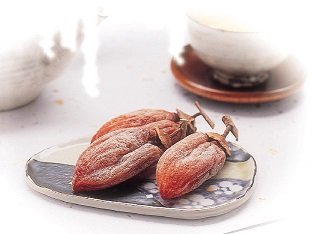Higashiizumo no Maruhata Hoshigaki / Higashiizumo no Maruhata Hoshikaki
| Registration Number | 87 |
|---|---|
| Name of the GI | Higashiizumo no Maruhata Hoshigaki,Higashiizumo no Maruhata Hoshikaki |
| Class | Processed Foodstuffs |
| Date of Protection | 2019/12/10 |
| Producing Area |
Shimane Prefecture
Hata area in Kamiito district of Higashiizumo-cho, Matsue City |
| Applicant - Name and Address | Shimane Prefecture Agricultural Cooperative (JA Shimane) 19-1 Tonomachi, Matsue City, Shimane Prefecture |
Producing Area
Higashiizumo no Maruhata Hoshigaki, a variety of dried Japanese persimmon (1), is made by drying persimmons in dedicated two- to four-story sheds.
While the flesh of the dried persimmon is a deep orange color, the surface is covered by powdery white persimmon sugar. Although even the center of the fruit is fully dried, the dried fruit has soft texture. Its sugar content reaches around 80%, and yet the fruit maintains sophisticated sweetness.
In recognition of the 400-year history of production, tradition, and quality, Higashiizumo no Maruhata Hoshigaki is in high demand, particularly as a luxury year-end gift (2).
The raw material of Higashiizumo no Maruhata Hoshigaki is the persimmon variety Saijo Gaki cultivated within the producing area.
Strains with a high sugar content that are cultivated in Hata area are designated as superior seed trees, and are used as scions for grafting onto rootstocks. Only these grafted persimmon trees are used to produce persimmons for Higashiizumo no Maruhata Hoshigaki.
For the processing of harvested persimmons, the stem is cut to an appropriate length, the sepal is removed from the fruit, and the fruit is peeled, after which the fruit is tied to a string, with the number of fruits limited to 10 per string in principle. The string is tied to the stem part of the fruit, and each fruit should weigh 110 g or less after removing the sepal and peeling.
Persimmons are then suspended in two- to four-story sheds dedicated to drying persimmons within the producing area, and sun-dried until they become fully dry in the center. Sulfur dioxide fumigation is not to be practiced.
Shipping standards require that the dried fruit has deep orange color, the dried fruit has not reabsorbed moisture and remains as soft as a human ear lobe, the surface of the dried fruit is covered by white powdery persimmon sugar, and the dried fruit is not contaminated by foreign materials.
Persimmons that satisfy all of the above standards are shipped as Higashiizumo no Maruhata Hoshigaki.
The producing area of Higashiizumo no Maruhata Hoshigaki., Hata area, is located in the eastern part of Shimane Prefecture, facing Lake Shinji (3) and Lake Nakaumi (4).
The area's clay-rich soil has outstanding water and fertilizer retention and drains well, offering suitable conditions for cultivating Saijo Gaki.
From late autumn to early winter, cool north-west seasonal winds blow into Hata area, and the temperature difference between daytime and nighttime becomes large, which is suitable for making dried persimmons.
Records show that, in 1809, a resident in Hata area built the first shed for drying persimmons, suggesting that sun dried persimmon production using dedicated drying space was already practiced about 200 years ago.
Today, 19 farmers produce Saijo Gaki in a total area of approximately 15 ha, with most of the harvested fruits being processed and shipped as dried persimmons. As of 2017, shipment is around 300,000 persimmons.
- Dried persimmons: They are made by tying together peeled astringent persimmons with a string and suspending them for drying in a well-ventilated place. It is said that in Japan dried persimmons have been made as ceremonial confectionary at least since the middle of the Heian Period (794-1185).
- Oseibo: in Japan, people customarily give gifts twice a year to "express appreciation" to people who have looked after them. Summer gifts are called "ochugen", while year-end gifts are called "oseibo".
- Lake Shinji: The seventh largest lake in Japan, located in the northeast area of Shimane Prefecture. It is a brackish lake and is connected to Lake Nakaumi via Hii River. The Lake is known for clam fishing and accounts for around 40% of the total catch in Japan.
- Lake Nakaumi: The fifth largest lake in Japan, located on the east side (ocean side) of Lake Shinji and extending over eastern Shimane Prefecture and western Tottori Prefecture. It is also a brackish lake, but in contrast to Lake Shinji, fish species such as Japanese sea bass are caught in quantities amounting to 300 to 400 tons a year.


